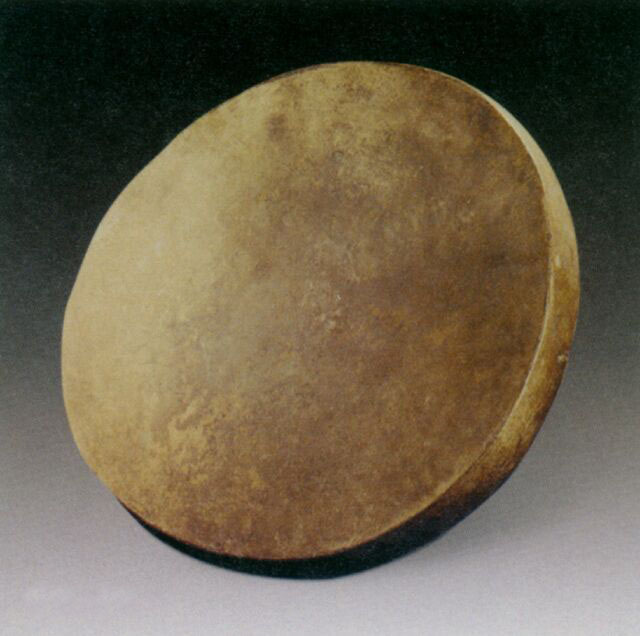dabo overview
 Dabu (Pinyin: Dá bo), the soul of Uyghur music, is essential in most dance and folk songs. Dabu's timbre is crisp and loud, the sound intensity varies greatly, and the playing skills are flexible and changeable, which can play a role in setting off the atmosphere of various music plots. Popular in the north and south of the Tianshan Mountains in Xinjiang Uygur Autonomous Region.
Dabu (Pinyin: Dá bo), the soul of Uyghur music, is essential in most dance and folk songs. Dabu's timbre is crisp and loud, the sound intensity varies greatly, and the playing skills are flexible and changeable, which can play a role in setting off the atmosphere of various music plots. Popular in the north and south of the Tianshan Mountains in Xinjiang Uygur Autonomous Region.During the Southern and Northern Dynasties, there were already Dabu in the Western Regions of my country. In the murals of the Northern Wei Dynasty (386-534) in the Thousand Buddha Caves in Dunhuang, there are single-sided drums with a drum-shaped oblate, one-sided skin and many small iron rings on the back. During the Sui and Tang Dynasties, Dabu was introduced to the mainland along with singing and dancing from the Western Regions. Bai Juyi, a great poet of the Tang Dynasty, wrote in the poem "Hu Xuan Nu": "Hu Xuan Nu, Hu Xuan Nu, the heart is in line with the string, and the hand is in response to the drum. When the drum sings, the sleeves are raised, and the snow flutters and dances." The close relationship between Dabu and singing and dancing. "The Western Regions Wenjianlu" (collected by Yunxiu), Volume 7, wrote: "The drums are the main music of the Hui music." It can be seen that Dabu also plays a commanding role in folk bands or singing and dancing. In the Qing Dynasty, Dabu was included in the court's Huibu music. Qing Yunlu and others compiled "Dynasty Ritual Instruments Schema" (Volume IX) with a more detailed record: "The imperial banquet is set to Huibu music. Dabu, wood Kuang, the top is covered with leather, shaped like a hand drum without a handle. The diameter is one foot, three inches, six centimeters, five centimeters, and the thickness is two inches, two centimeters, seven centimeters, and five centimeters. ) contained: "Dabu, wooden framed leather, shaped like a tambourine without a handle, with two sizes, one side is one foot, three inches, six minutes, five centimeters, and the other side is one foot, two inches, two minutes, four centimeters, all painted yellow. Lacquer, painted lions on the face, and hit them with hands." For a long time, Dabu has been widely spread among the folks of the Western Regions and has become one of the popular musical instruments of the people.
The drum frame is made of mulberry wood, in the shape of a flat circle, and one side is covered with sheepskin, pony skin or donkey skin, and the inner side of the drum frame is decorated with more than 30 small iron rings. Since the 1950s, Dabu has also used python skin to cover his face to make his pronunciation clear and loud. Among the Uyghur folk, Dabu has different specifications, and is generally divided into three types: large, medium and small. The larger drum has a diameter of 44 cm to 52 cm and a drum frame height of 5 cm to 5.5 cm; the middle drum has a diameter of 32 cm to 40 cm and a drum frame height of 4 cm to 4.5 cm; the small drum has a diameter of 20 cm to 28 cm , The drum frame height is 3 cm to 3.5 cm. Uyghur folk ensembles or hand drum accompaniment often use medium or large drums, and perform solo performances; Muqam accompaniment bands often use small drums. The Chinese Musical Instrument Museum of the Institute of Music of the China Academy of Arts in Beijing has collected many faces of Dabo, including two large and small faces, which are included in the large-scale catalogue of "Chinese Musical Instruments Illustrated Guide".
Dabu is the soul of the band, the biggest names in festivals, especially on Islamic festivals such as Rozi, Eid al-Adha or wedding celebrations, when men, women, young and old gather together, when the Dabu drum is played, people dance to the drum music. The scene presents the climax of the carnival. In happy days, it can convey people's passion and happiness to everyone through sound and percussion, and the deep affection permeates the air and people's hearts, so that you can experience and quickly integrate into this kind of Atmosphere, therefore, Dab is also known as the "player of the soul". Dafu is not only an accompaniment instrument for singing and dancing, but also a unique decoration.
- Pinyin:Dá bo
- origin:The prototype or originated from the Middle East
- Classification:Uyghur musical instruments
- popular area:Xinjiang Tianshan North and South
overview of other similar instruments
- sanyanxiao overview
- Daguangxian overview
- Leiqin overview
- hahao overview
- yandundagu overview
- Han Xiaozheng overview
- Fang Xiang overview
- guanzi overview
- zhuqin (Dao Qin) overview
- zhuiqin overview
- bangzi overview
- three-stringed piano overview
- Gehu overview
- xiao overview
- xiaokonghou overview
- Konghou overview
- Sheng overview
- suona overview
- hulusi overview
- gushao overview
 渝公网安备 50010702504639号
渝公网安备 50010702504639号